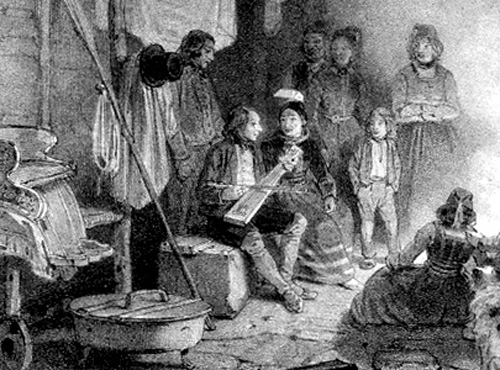Talking about “original” or “indigenous” musical instruments in Iceland is tricky. Unlike the continental Scandinavian countries, there’s little evidence of medieval musical culture — far fewer paintings, wood or stone carvings, that depict actual instruments. In fact, the earliest depiction of the national instrument, the Langspil (a bowed zither) is from 1836 — and from a French travel narrative, no less:

Twenty years later, the first signifiant work on the Langspil was published, a guidebook on how to play:
At its most basic, the Langspil is a variant of the instrument Americans know as a Dulcimer. Such instruments, which can all fall under the general term Zither, have a long history in Europe. A large part of the original settlement of Iceland came from Norway, and a zither known as the Langeleik are pretty well-attested there — the earliest surviving from the 16th century. (I’m not sure whether the current thinking is that the Langeleik/Langspil travelled with the Norwegians during the 9th century settlement period or much later.)
Regardless, we can probably treat the Icelandic Langspil as a local adaptation of a common European instrument class. In the engraving above from 1836, we see a farmer playing the instrument with a bow, instead of plucking with fingers or a pick. In modern instruments being produced today, both methods are supported. Sometimes the practice is to unhook one of two larger strings when bowing, reconnecting it when the player wants to use a pick. Below, a researcher plucks various strings while holding some of them down against the fretboard:
Of course, there’s a slippery slope between the specifically-Icelandic Langspil, and any zither produced in Iceland. Is the difference in the shape of the instrument, or its ability to be bowed, or the decoration carved or painted onto its surface? Below, an uncle-and-nephew team of Icelandic instrument makers consider a conventional zither, left, and a Langspil, right:
Both were made in Reykjavík in 2011, and both can be strung and played in a similar fashion. Besides the physical difference in the bodies’ design, the placement of the fretboard on the Langspil is different. But in general, as with all folk instruments, individual examples exist in a spectrum of different design choices and stylistic traditions, rather than inhabiting fixed positions such as Violin/Viola/Cello.